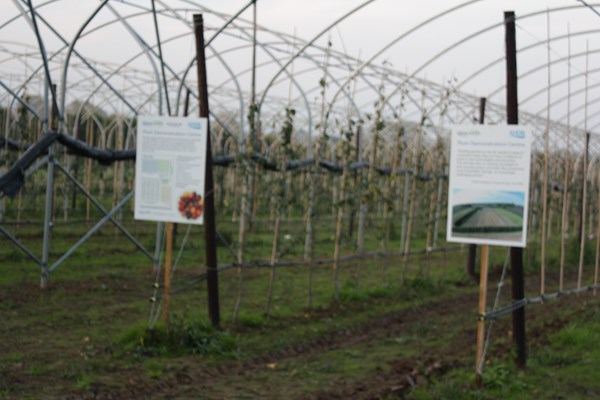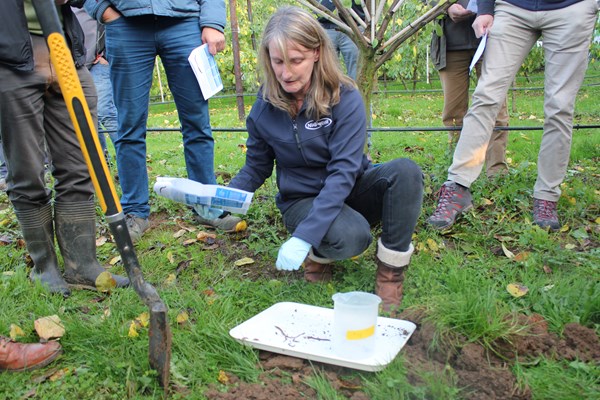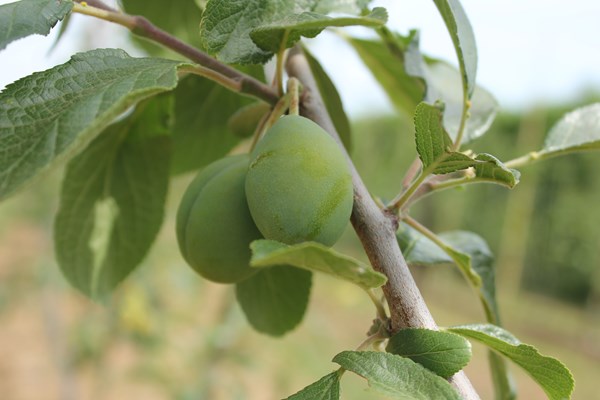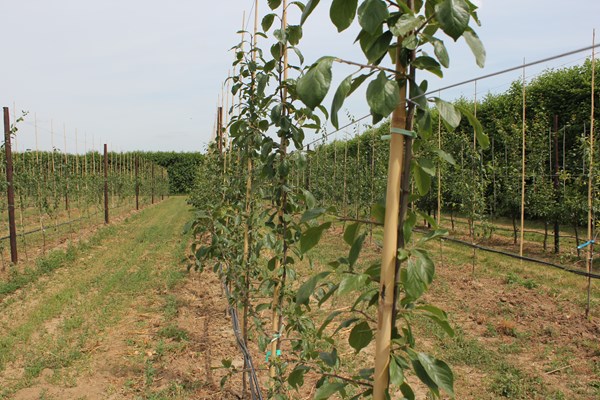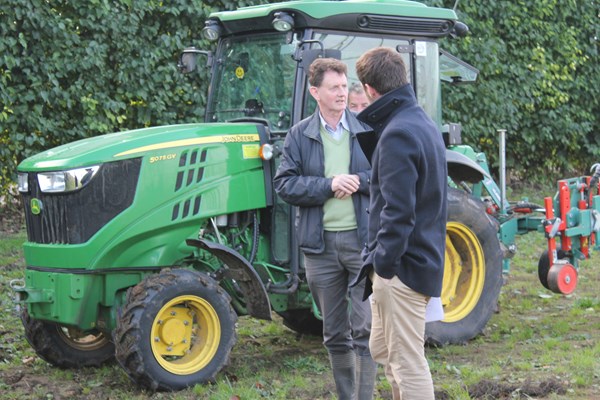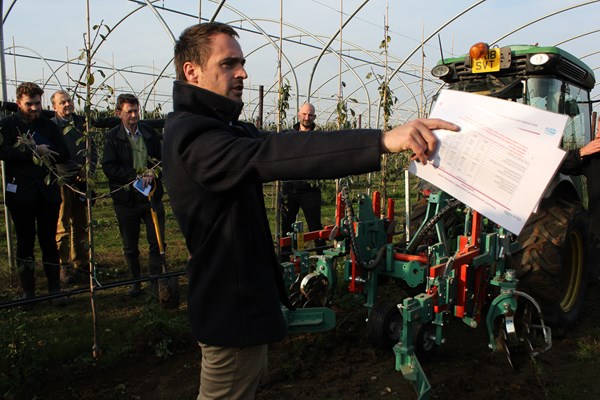Please click here to access the main AHDB website and other sectors.
- Home
- Projects
- Farm Excellence
- The Plum Demonstration Centre
The Plum Demonstration Centre
About The Plum Demonstration Centre
- AHDB were part-funders of the Plum Demonstration Centre at NIAB EMR in Kent until 2022. Other funding has been sought to continue the project beyond the lifetime of AHDB Horticulture - find more information on the NIAB Plum Demonstration Centre webpage
- Several new plum orchards were planted in Kent following the completion of a four-year INNOVATE project on plums
- The goal of the centre is to demonstrate best practice in plum production, but also weed control, use of organic mulches, optimum soil management practices and earwig-safe spray programmes
- The Mechanical Weeder part of the IWM PRAISE Project was demonstrated at the centre
The Plum Demonstration Centre is a centre of excellence for Tree fruit growers to show best practice, the latest practical research and to implement new technology.
Several new plum orchards were planted in partial fulfilment of an Innovate UK (IUK project), located in Kent following the completion of a four-year project on plums.
AHDB part-funded one of these at NIAB EMR to demonstrate some of the outcomes from the research project on ‘Sustainable increase of UK plum production’.
The project focused on enhancing yields, reliability of cropping, extending the production season from July to October, and improving fruit value by raising the quality of the fruit being marketed and consumed.
The results of the project are available to the industry in a new Plum Best Practice Guide that can be found on NIAB’s website here.
Rootstock comparisons
The performance of Victoria was compared on four rootstocks (four replicated 5-tree plots) of varying vigour including VVA1, Wageningen, Wavit and St. Julian A. The planting allowed replicated comparisons of the performance of Victoria including tree size/vigour, flowering time, ripening time/season, disease susceptibility, productivity and fruit size and quality.
Training system comparisons
The performance of Victoria was compared on different training system/rootstock combinations (Narrow table-top, Narrow A frame, Oblique spindle and Super spindle on rootstocks VVA1, Pixy, Wavit and St. Julian A) and two single rows of Victoria were compared on Fan and Candelabra systems.
Variety comparison
In 2020, 23 new selections and varieties were planted in a dedicated variety trial plot to gather yield and quality data from a range of varieties that extended the season from the start of July until the end of September. This included varieties in the table which are compared to Victoria as the standard.
|
Variety |
Cropping season |
Variety |
Cropping season |
|
Herman |
Early July |
Top Five |
Late August |
|
Katinka |
Mid July |
Victoria |
Late August |
|
P7-38 |
Mid July |
Haroma |
Early September |
|
Juna |
Mid July |
Seneca |
Early September |
|
Meritare |
Late July |
Marjory |
Early September |
|
P6-19 |
Late July |
Top Taste |
Mid September |
|
Opal |
Early August |
Coe’s Golden Drop |
Mid September |
|
Lancelot |
Mid August |
Laxton’s Delicious |
Mid September |
|
Avalon |
Mid August |
Top Hit |
Mid September |
|
Julieum (Jubilee) |
Mid August |
Haganta |
Late September |
|
Reeves |
Mid August |
Top End |
Late September |
|
Ferbleu |
Late August |
|
|
Interestingly, following the IUK funded plum project, three other trial orchards were planted by commercial plum growers in Kent to showcase different plum varieties. These included A. C. Hulme & Sons (early varieties), Highwood Pluckley Ltd (late varieties) and G. H. Dean (varieties with high yield and quality potential).
Protected cropping
An area at the centre was set up to demonstrate the difference in performance of Victoria grown under polythene clad multi-bay tunnels compared to unprotected Victoria.
Demonstration of mechanical thinning and weed control aids
A number of mechanical aids for thinning flowers and controlling weeds in the crop row are available to growers in the UK. These and other machines were demonstrated in open events for growers to view their performance.
Root pruning was demonstrated by assessing half a row of root pruned versus half a row without. The effects on tree vigour were recorded.
Comparison of irrigation and fertigation programmes
Soil matrix potential sensors were installed in five rows of Victoria on Wavit rootsocks, which allowed them to trigger trickle irrigation when the soil reaches water deficit set points. Irrigation was triggered initially when -50 Kpa was reached, then gradually reduced to -75 and then -100 and irrigation only applied when this threshold was reached. Half of the rows were irrigated this way and compared to the other half, which were irrigated routinely around 1 hour every day.
Fertigation programmes developed by NIAB EMR in consultation with Yara were employed at the centre. In a comparison of two different approaches, half of the trees were treated with the fertigation programme throughout the growing season and half were treated only at times during the season when the trees are known to respond to fertigation. A long-term comparison of growth and yields will be made. This work will also draw upon the results of AHDB Projects TF 198 and TF 210 along with the EU Fertinowa project.
Comparision of the use of organic mulches
Many commercial growers now use organic mulches in the tree row to suppress weeds, conserve soil moisture and improve soil texture and soil structure in the root zone. A long-term comparison will be made of trees treated with organic mulch and those not treated.
Earwig-safe spray programmes and conservation biocontrol
Results of AHDB funded research projects on preservation of earwigs in orchards (TF 196, TF 220 and TF 223) and conservation biocontrol are being implemented at the Centre. This includes implementing ‘earwig-safe’ spray programmes, deploying earwig refuges, employing wild flower strips around the centre and between crop rows (in certain areas) and the use of beetle banks. The numbers of earwigs and pollinators are assessed and recorded. Comparisons of earthworm numbers are also being made between bare soils, grass strips and wildflower areas.


